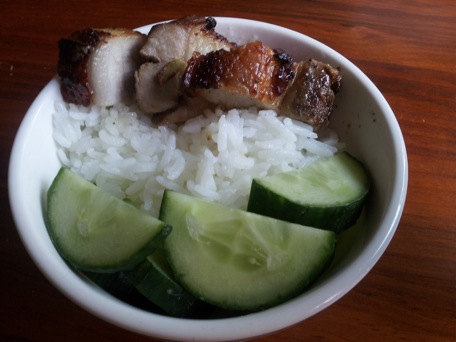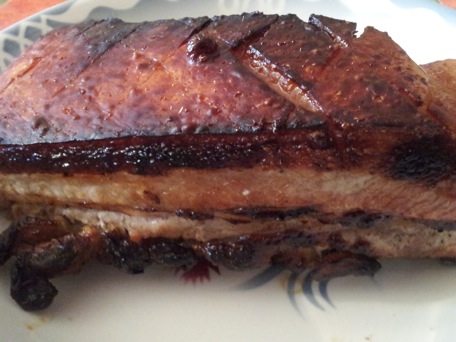Thit heo quay: crispy pork belly
A classic.

Recipe type: Basics, Festival, Main Dish
Cuisine: Vietnamese
Preparation time: 1 h
Cooking time: 30 mins
Total time: 1h 30 mins
Serves: 4
Aka thịt heo quay, a beloved Vietnamese favourite [1]. OK, so fair warning: this isn’t a complicated recipe per se, but it requires quite a fair bit of planning, since the actual preparation begins on the previous day, and the meat has to be taken out of the fridge an hour in advance. The main attraction to this is the crispy skin, so getting it to happen is a key point of the recipe. The trick is to an extra amount of oomph: many recipes use baking soda for the purpose, but the one I had used vinegar and salt. Also, you should get your pork skin as dry as possible, hence the night in the fridge and the boiling water trick.
- 500g pork belly with skin on
- 1+1 tablespoon rice vinegar
- 1 teaspoon salt
- 1 teaspoon hoisin sauce
- 1 teaspoon 5 spices
- 1.5 teaspoon light soy sauce
- 1.5 teaspoon honey
- ½ teaspoon crushed garlic cloves
- The day before you intend to cook the meat, scrape the skin clean (only if the actual skin is bristly; in most Western countries I believe the skin is already cleaned, ie cream and smooth, and doesn't need extra treatment). Pour 1L of boiling water on the skin, and then leave the meat skin-side down 1 min in a little of the boiling water (NOT in all of it, or you're just going to start cooking the meat. You're basically just trying to tighten the skin pores with hot water). Dry it with a paper towel.
- With a sharp knife, cut into the skin in the shape of lozenges, then prick it all over with a fork or a toothpick. Turn the meat over, and do the lozenges incisions for the meat side, cutting fairly deep; almost all the way through. The first operation is so the skin doesn't tighten in a messy way on top of the pork belly; the second is is so the marinade penetrates.
- Mix the honey, soy sauce, hoisin sauce, 5 spices and garlic together. Rub the marinade on the meat side of the belly. When I say rub, it's in all the interstices, so don't hesitate to do it vigorously with your hands, making sure every bit of flesh (including those on the sides and within the lozenge incisions) is covered in marinade.
- Turn the meat on the skin side. Rub 1 tablespoon of rice vinegar into the skin, then the salt, making sure it penetrates (again, fingers are your friends).
- Put the meat in the fridge for an entire night (or at least 6 hours if an entire night isn't available), and let it marinate uncovered. This is to do two things: the first, so that the marinade penetrates into the meat side, and the second to dry the skin, hence the "no covering" part.
- On the following day, withdraw the meat from the fridge an hour before cooking, and let it warm up to room temperature.
- Preheat the oven to 200°C. When the oven is warm, put on a tray with a little water at the bottom, and put the meat, skin side up, on a grid about halfway up the oven. Cook for 20 minutes.
- Cautiously withdraw the meat and brush the remaining 1 tablespoon vinegar on the skin.
- Then turn on the grill, and put the meat back in. This is where it's IMPERATIVE that you stay around. The skin is going to start crackling with very audible noises, and you need to keep an eye on it as it hardens. Basically it goes through the following stages: crackling, mildy golden, golden and hard to the touch, and then burnt. You want to stop at the stage when it's still golden and crispy rather than charcoal... (this is fast in my oven, about 5-7 minutes top. DON'T leave the kitchen or you'll regret it. Also don't hesitate to withdraw the meat from the oven and touch to see how crispy the skin has got).
- Get the meat out of the oven, and chop it into bite-sized pieces. Eat with rice and a salad, or a fresh green vegetable to offset the richness of the meat.

[1] It’s a Chinese dish, strictly speaking. But given how prominent thịt heo quay has become in Vietnam, I’m adding it to the official Vietnamese repertoire along with xá xíu and other dishes involving 5-spice.